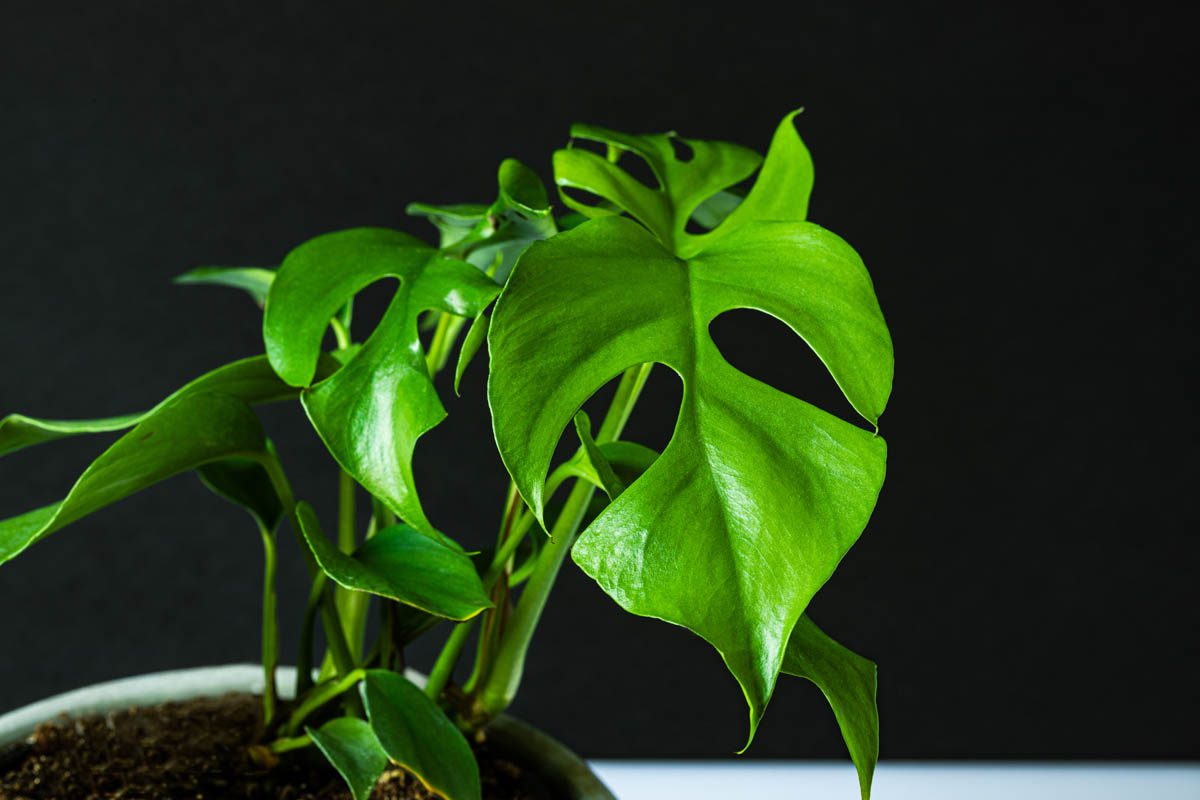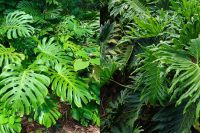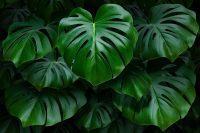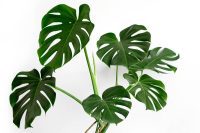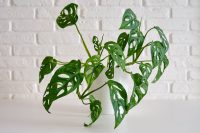What is mini monstera? Ι Description Ι Care Ι Propagation Ι Toxicity Ι Pests and diseases Ι Frequently asked questions
What is mini monstera?
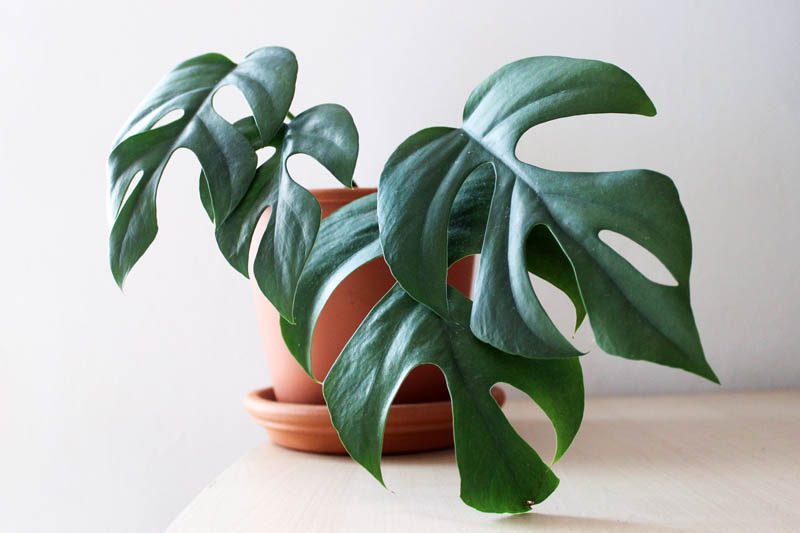
Mini monstera (Rhaphidophora tetrasperma) is a tropical plant native to the rainforests of Thailand and Malaysia. The plant has become popular in recent years as a houseplant for its glossy green, pinnatifid foliage and ease of care.
The scientific name Rhaphidophora tetrasperma was given by Sir J. D. Hooker. Despite its common name, it is not actually a species of Monstera, its name is due to the similarity of its leaf shape to the Swiss Cheese Plant (Monstera deliciosa). The botanical name Tetrasperma means ‘four seeds’ in Latin, tetra > four, sperma > seeds.
The Rhaphidophora family comprises approximately 100 species¹.
| Family | Araceae |
| Botanical name | Rhaphidophora tetrasperma |
| Common names | Mini monstera, Philodendron ‘Ginny’, Philodendron ‘Piccolo’, Monstera ‘Ginny’, Amydrium ‘Ginnie’, Epipremnum ‘Ginny’ |
| Plant type | Perennial, vine |
| Flower colour | White |
| Sun exposure | Bright, indirect light |
| Soil pH | Neutral, acidic |
| Mature height | 180 – 240 cm (6 – 8 feet) |
| Soil type | Rich but well-draining |
| Habitat | Rainforests |
| Native to | Southern Thailand and Malaysia |
Related: Can you grow variegated Monstera from seed?
Description
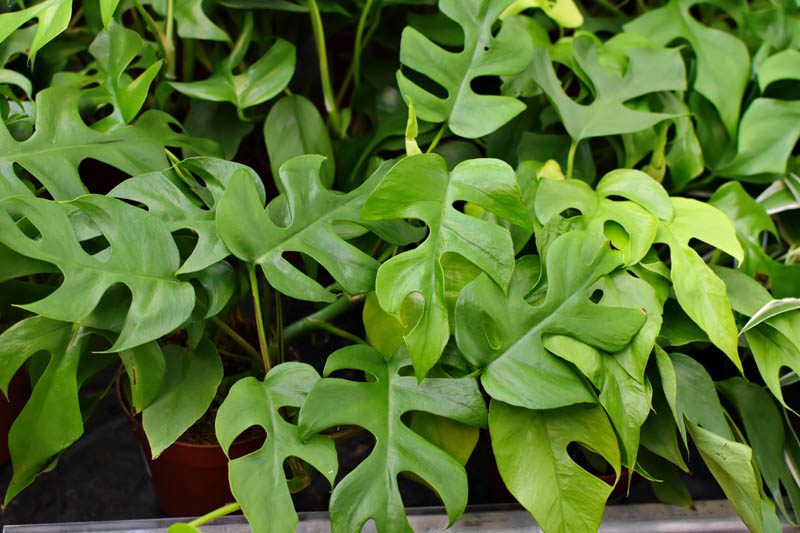
Mini monstera is a fast-growing climbing vine in the family Araceae, which is commonly known as the aroid family. It has aerial roots that help it attach to tree trunks, and it produces elongated, arrowhead-shaped leaves that are deeply lobed (pinnatifid) and divided into 3-5 segments. The petiole or leaf stem is elongated, measuring around 15-25 cm in length.
The adaxial (upper) surface of leaf is a deep green colour, smooth and glossy. This surface is responsible for photosynthesis, the process by which the plant uses sunlight to create energy in the form of glucose. Stomata are also located on the adaxial surface. These small pores allow for gas exchange and are important for the plant’s ability to take in carbon dioxide for photosynthesis and release oxygen. The adaxial surface is also sometimes used to help identify the plant species, as it can have unique characteristics such as variegation, texture, and shape.
The abaxial surface of the mini monstera leaf refers to the lower surface which faces downwards and is usually in contact with the plant’s stem or other objects. The abaxial surface is typically a lighter green colour than the adaxial surface and is usually less glossy. This surface of the leaf is responsible for gas exchange, as it also contains stomata. The abaxial surface is also where the veins of the leaf are located, which can be used to help identify the plant species. The veins on the abaxial surface of the mini monstera leaf are often prominent and can be either green or a contrasting colour, depending on the variegation pattern of the leaf.
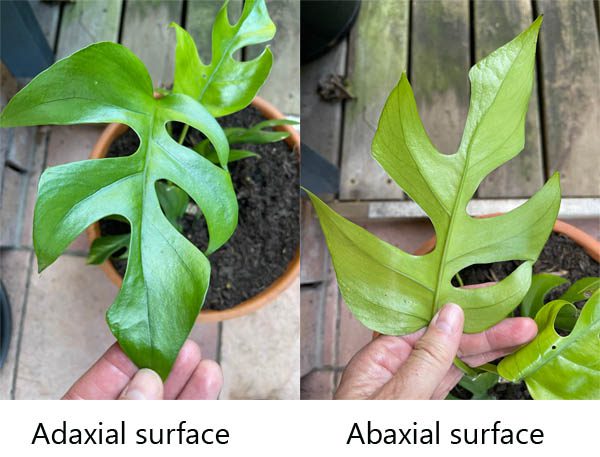
Mini monstera is dioecious, which means that male and female flowers are produced on separate plants. The flowers are small and inconspicuous, with the male flowers producing a white inflorescence and the female flowers producing a green one.
In its natural habitat, mini monstera produces small clusters of flowers known as inflorescences that emerge during the summer months. The inflorescences are composed of a spadix surrounded by a spathe. Once the flowers have been pollinated, they give way to small, berry-like fruits. These fruits are not edible and are of little ornamental value.
While mini monstera was once considered a rare plant, it is becoming more widely available in nurseries and online stores. Cuttings can also be found for a reasonable price on Facebook Marketplace. If buying from a private seller, I recommend choosing a cutting that already has a well-established root system. While it was once considered a rare plant, it has become more widely available in nurseries and online stores. The variegated mini monstera is considered rare and carries a high price tag as a result. However, prices are starting to come down. Once again, choose a plant with an established root system.
Care
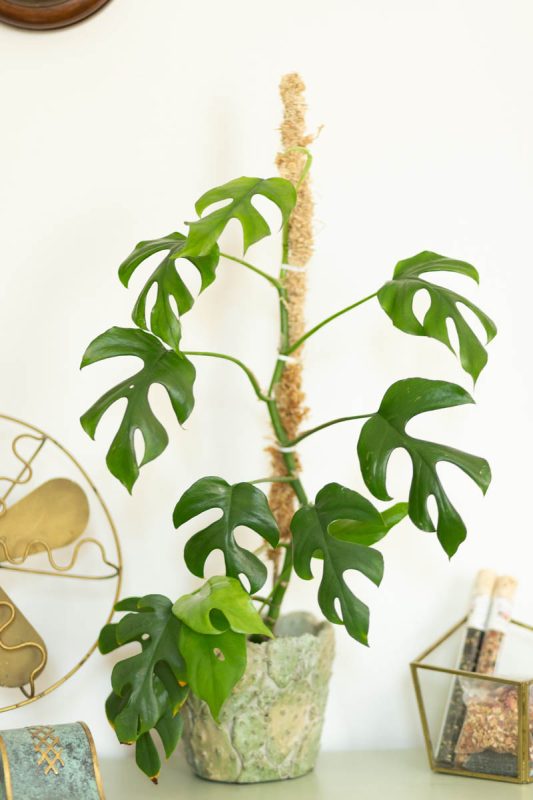
| Light | Bright, indirect light. Avoid full light as this will burn the leaves. Remember, in their native habitat, mini monstera grows beneath larger trees and receives filtered light. My mini monstera is in a north/west-facing position (southern hemisphere), but about 2 metres from the glass doors.If mini monstera is grown in too dark an environment, it will not thrive as its growth will slow and it will produce small leaves. A grow light is recommended if your mini monstera is located in a dark room. |
| Water | The frequency of watering depends on the location of your mini monstera, the size of the pot and the ambient temperature.
Mini monstera like evenly moist soil, but not overly wet. Water when the top 2.5 cm (1 inch) is dry, but do not allow the soil to completely dry out between watering. As a guide, water twice a week in the warmer months but every 7 – 10 days when it’s cooler. |
| Fertilising | Feed a good-quality high-nitrogen liquid fertiliser once every two weeks during the active growing season. I usually use Powerfeed but have just purchased We the Wild which has good reviews, so we will see how it goes. Cut back on fertilising in winter, I generally feed once a month. |
| Soil | I always like to repot houseplants I bring to the home so that I know they’re in fresh soil. A well-draining potting mix is suitable for mini monstera. Some growers like to make a mix of 1/3 peat moss or leca (lightweight expanded clay aggregate) for extra drainage, 1/3 pearlite to help aerate the soil and 1/3 premium potting mix. If you can’t find pearlite or leca at your local garden centre, they are available to purchase online. |
| Repotting | Mini monstera can tolerate being slightly root bound, but it is recommended a root-bound plant be repotted as soon as possible. As a rule, your mini monstera should be repotted every 1 – 2 years.
Carefully remove the plant from its pot and check the roots. Signs a mini monstera is rootbound include soil that dries out rapidly, visible roots in the drainage hole, and stunted growth. If the plant is rootbound, repot into a new pot one size larger than the current pot. Resist the temptation to go too large as overpotting can retain more water in the soil, which can cause root rot. Ensure the pot has a hole in the bottom to allow excess water to drain out of the pot. Look for a heavy ceramic pot that will be able to accommodate both the plant and |
| Humidity | Mini monstera prefers high humidity levels of 60-70% but can tolerate lower humidity levels as long as they are not exposed to extended periods of dry air.
Misting can increase humidity temporarily, it does not provide long-term benefits for the plant. Provide humidity for your mini monstera by placing a tray of water near the plant or using a humidifier. You can also group your plants together, as they release moisture through transpiration, creating a naturally humid environment. Another way to increase humidity is to place a layer of pebbles in a tray and fill it with water, then place your plant on top of the pebbles, making sure the water doesn’t touch the bottom of the pot. This creates a humid microclimate around the plant. |
| Pruning | Mini monstera can be a vigorous grower if it becomes too large, snip off some stems with nodes, put them in a glass of water and propagate. You can either sell the cuttings or give them to friends and family. |
| Climbing | Mini monstera is an epiphytic plant, (a plant that grows on other plants, but is non-parasitic), and prefers to grow upright, which can be achieved by providing a moss pole. Carefully secure the plant to its pole with plant ties to train it to climb up the pole.
Mini monstera is an exceptional climber and will climb internal or external walls if allowed. They produce adventitious roots that attach to surfaces they are growing on such as tree trunks or walls. The adventitious roots are a type of root that grows from non-root tissue such as stems. These roots anchor the plant to surfaces such as tree trunks or walls, facilitate nutrient and water absorption and support new growth. Adventitious roots secrete a sticky, gel-like substance called mucilage that helps the plant anchor itself to surfaces and absorb moisture and nutrients from it surroundings. While mini monstera is a climbing plant, it can also be trained to grow in a hanging basket or allowed to trail down a support structure. |
| Leaf cleaning | Wipe down leaves with a damp (not soaking wet) microfibre cloth every 2 months to remove dust and debris. Avoid wiping newly emerged leaves until they have had time to harden. |
Propagation
The easiest way to propagate mini monstera is asexually by taking stem cuttings which can be rooted in water. It is important to understand basic anatomy so that you know where to take the cutting.
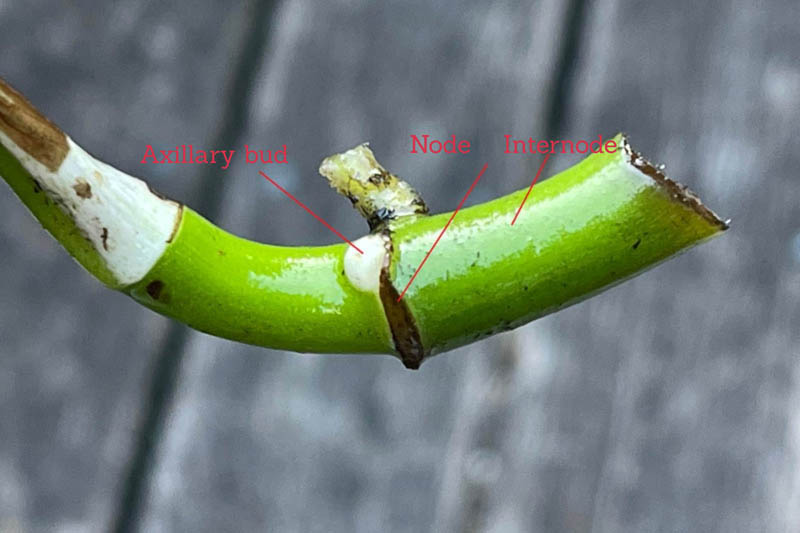
- Using a sterilised pair of sharp scissors, take a snip from the plant, which must include a node (the point on the stem where leaves emerge). Each node contains a small bud known as an axillary bud which gives rise to new shoots and leaves. The developing leaves are protected by brown papery structures called cataphylls, which are shed once the leaf has fully emerged.
- If there is more than one leaf on the cutting, remove the bottom leaves, leaving one remaining one at the tip.
- Place the node into a clear glass of clean water, with the leaf above the water. Some people like to dip the cutting in rooting powder, but I have never found it necessary due to the ease with which mini monstera propagates.
- Place the glass on a bright windowsill.
- The cutting will develop roots from the node within 2-4 weeks.
- Once the roots are 5 cm (2 inches) long, plant them in premium quality potting mix (see above for making the perfect substrate mix for your mini monstera).
Toxicity
Mini monstera is toxic to pets and humans. The toxic principle is needle-like insoluble calcium oxalate crystals known as raphides that penetrate the delicate tissues inside the mouth causing pain and in some cases swelling. If this occurs, remove any remaining plant matter from the mouth and offer the cat or dog a drink of something tasty such as tuna juice or milk.
Pests and diseases
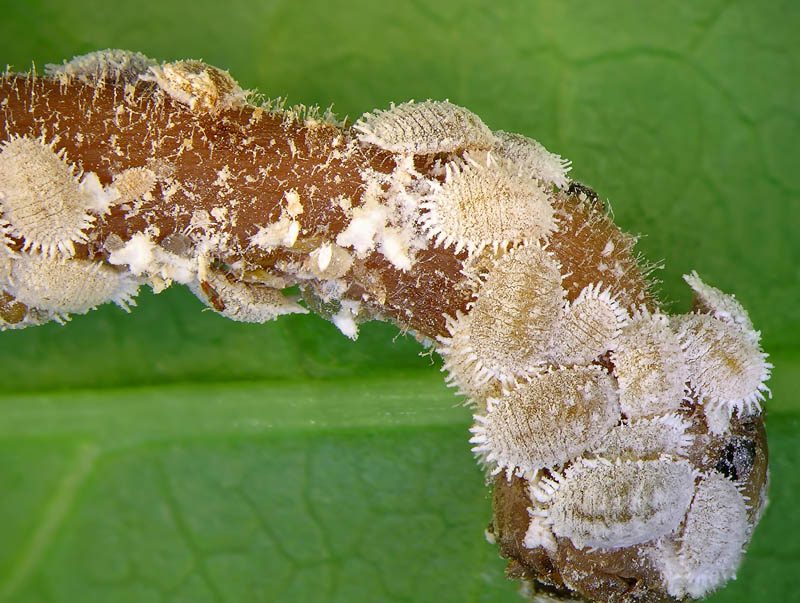
My personal experience is mini monstera seem to be less prone to pests than other plants (especially my Alocasia, which the spider mites, in particular, seem to love), but it is still possible. Always purchase your mini monstera from a reliable supplier, to reduce the risk. It is good to get into the habit of inspecting the leaves when you are watering, and don’t forget to look on the underside of the leaves where pests can hide.
Pests:
- Spider mites – A tiny arachnid belonging to the Tetranchidae family that can cause webbing and yellowing of the leaves. Spray affected plants with insecticidal soap or neem oil.
- Mealybugs – Small, soft-bodied insects that belong to the family Pseudococcidae. Spray affected plants with neem oil or insecticidal soap.
- Scale insects – Small, brown or black sap-sucking insects that belong to the order Hemiptera. Scale insects attach themselves to the plant, inserting their mouthparts into the plant tissue and sucking out the juices. Some species of scale insects produce honeydew, a sticky substance that attracts other pests such as ants or wasps. Affected plants develop wilting and yellowing of leaves. Treat with rubbing alcohol or insecticidal soap.
Diseases:
- Root rot – A disease caused by several pathogens and/or overwatering. Excess water in the soil or invading pathogens damage or destroy the roots which makes it difficult for them to absorb water and nutrients. The roots become black, mushy, and have a foul odour. Unfortunately, root rot is extremely difficult to treat. Remove the plant from its pot, use sharp, sterile scissors to cut away any dead or diseased roots, and repot into fresh potting mix and a new pot.
- Leaf spot – A common foliage disease that can be caused by various fungal or bacterial pathogens, including Xanthomonas campestris, Cercospora, and Septoria species. The disease is characterised by small, circular or irregular-shaped spots on the leaves, which can range from brown to black with a yellow or brown halo around the edges of the spots. Other symptoms include wilting, premature leaf drop, and a general failure to thrive.
- Powdery mildew – A fungal disease that appears as a white, powdery coating on the leaves and can be treated with a fungicide or neem oil.
Frequently asked questions
Is there a variegated mini monstera?
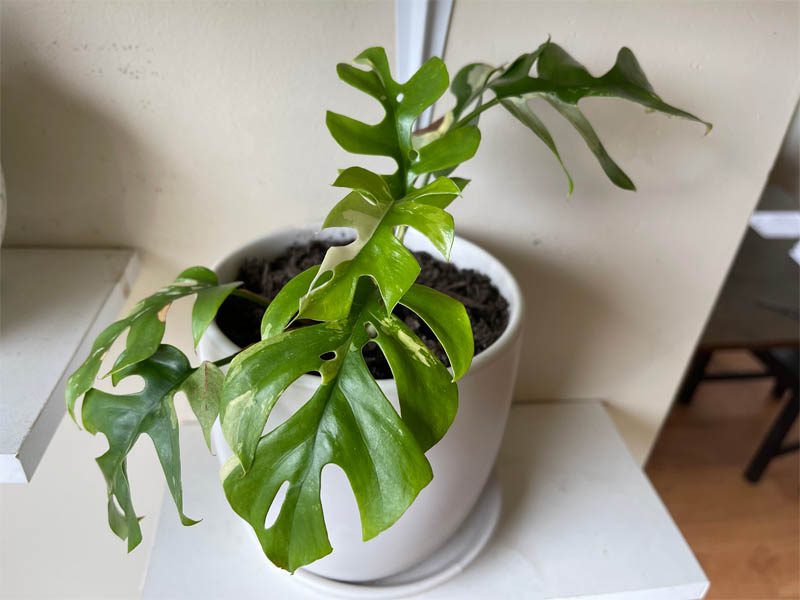
Yes, there is a variegated mini monstera (Rhaphidophora tetrasperma ‘Variegata’) but it is one of the rarest houseplants on the market and comes with a hefty price tag. You will not find variegated mini monsters for sale in nurseries, but they are available online. Prices used to start at $1,000 for a single leaf cutting, but are down to the low hundreds now. The most expensive houseplant ever was a variegated mini monstera that sold for $27,000.
What is the difference between mini monstera and Swiss cheese plant (Monstera deliciosa)?
- The leaves of mini monstera are considerably smaller than those of a mature Swiss cheese plant. The image below shows the size difference between mini monstera and Swiss cheese plant. The mini monstera leaf has been placed directly onto the Swiss cheese plant leaf which is 5 or 6 times larger.
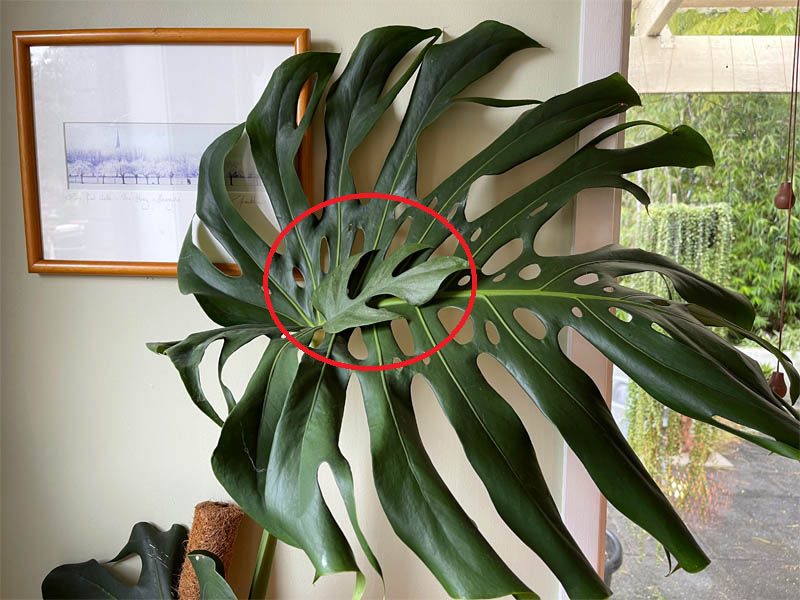
- Both mini monstera and Swiss cheese plants have pinnatifid (slits) in their leaves, the Swiss cheese plant also has holes (fenestrations) which mini monstera generally doesn’t have.
- Mini monstera comes from Thailand and Malaysia, Swiss cheese plant comes from Central America and Southern Mexico.
- The mature leaves of the Swiss cheese plant are somewhat dry and leathery, while the mini monstera leaves are considerably softer.
How fast does mini monstera grow?
This is my mini monstera photographed 11 months apart, as you can see, there has been considerable growth in this period. We live in a temperate climate. As we didn’t provide it with a moss pole, it climbed up the wall. At some point, we will have to cut it back as it’s getting a bit out of hand.
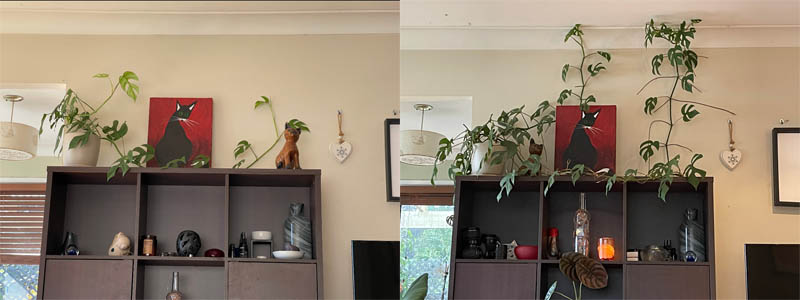
Is mini monstera a philodendron?
Even though mini monstera is sometimes called Philodendron ‘Ginny’, mini monstera is a member of the Rhaphidophora genus.
How big does mini monstera get?
Mini monstera can grow to approximately 180 – 240 cm (6 – 8 feet). If your mini monstera grows too much, it is easy to cut back.
Can I grow mini monstera in water?
Mini monstera can be propagated in water, but once it has rooted, it should be transferred to well-draining soil which contains all the nutrients your plant will need. If you would prefer to grow mini monstera in water, a hydroponic set-up will be required. Hydroponics is a method of growing plants without soil, using nutrient-rich water to provide the plant with the necessary nutrients to grow.
A hydroponic set-up includes a container, a substrate such as leca to support the plant, and a nutrient solution. The nutrient solution must be pH balanced and include all the necessary macronutrients and micronutrients that the plant needs to grow.
Yellow or brown leaves on your mini monstera
Soft and yellow leaves are usually a sign of overwatering or lack of light. The soil must be moist but not saturated and light should be bright, but not direct.
Crispy brown leaves may be too much sun exposure, not enough water or lack of humidity.
Resources
1. Govaerts, R., Frodin, D.G., & Radcliffe-Smith, A. (2000). World Checklist and Bibliography of Araceae (and Acoraceae). Kew Publishing. p. 375.
Julia is a writer and landscape consultant from Wollongong with a love of horticulture. She had been an avid gardener for over 30 years, collects rare variegated plants and is a home orchardist. Julia is passionate about learning and sharing her knowledge of plant propagation and plant toxicology. Whether it’s giving advice on landscape projects or sharing tips on growing, Julia enjoys helping people make their gardens flourish.
